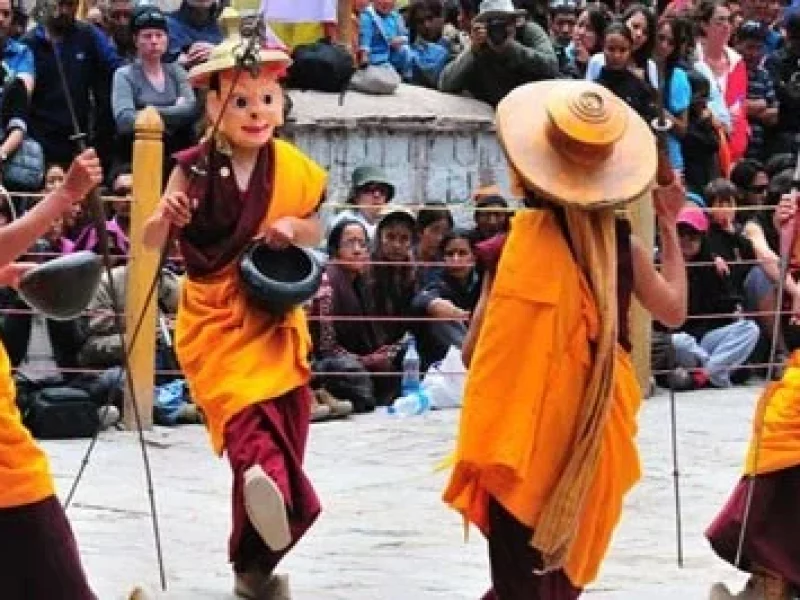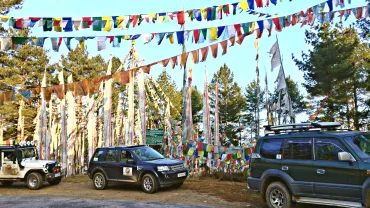Festivals of Ladakh
In Ladakh every occasion marriage, birth, harvesting, commemoration of head Lamas founding of the monastery, Losar (new year) and flowering is marked by feasting, dancing and the singing of folksongs that forms a part of its living heritage. Most of the festivals are held in winter but some popular festival take place in summer too. The monastic festivals are the heart of all the festivals. They are performed by Monks wearing colorful silk garments and different facial mask.
Click for – Ladakh Festivals Calendar – 2022
Some of the prominent festivals are as below.
THE LOSAR FESTIVAL
Losar is the Tibetan word for “New Year”. Losar is an important holiday / Festival in Ladakh and other parts as well. Though this is also common in Tibet, Bhutan and in Nepal. The Losar (New Year) celebration is followed by Galdan Namchot, the birth anniversary of Tsogkha pa who introduced Gelukpa School of order. During Namchot people illuminate their houses, monasteries and mountains and make offerings in the houses and monasteries.

In Ladakh Losar festival being celebrated nearly two months before than Tibet Losar Festival. Reason being is that In early 17th century, King Jamyang Namgyal decided to lead an expedition against the Baltistan forces in winter; therefore he decided to celebrate the festival two months before, later it became a tradition.
The festival lasts for around a month, therefore you have entire December to witness in different part of Ladakh. During this period people fed their Gods, deities, ancestors and even the animals. Images of Ibex are made as auspicious symbol, walls of the kitchens are dotted and are believed to bring prosperity in coming year. All family members get together to celebrate if someone missing will have their cups filled with tea by their name.
THIKSE GUSTOR
This two day long festival is held mainly in the Spituk, Thiksay and Karsha Monastery in Zanskar in down south of Ladakh.

Gustor means “Sacrifice of the 29 th day. The celebration end with the dismembered and dispersal of the Torma (Sacrificial Cake) by the leader of the Black hat dancers in a ceremony called “Argham” or “klling”. This symbolizes the destruction of all form of evil. And also re-dnacts the assassination of the Tibetan apostate King Lang-Darma, by a Buddhist monk in the mid 9 th century. In some monasteries, an effigy symbolizing the stronger forces of evil is burnt at end of the festival. You may visit Thikse monastery near Leh town where you will witness a mask dance worn by the dancers represent the guardian divinities(harmapalas) of the Buddhist pantheon.
GALDEN NAMCHOT
This festival is mainly welcoming the beginning of New Year called Losar Festival. The festival of Galdan Namchot is celebrated as the birth anniversary of Galden Thripa His Holiness Gyalwa Tsonkhapa and also as the Buddhahood of Tsongkhapa. The Tibetan saint- scholar Tsonkhapa founded the Gelukpa school of Tibetan Buddhism during the 14th century. The Gelukpa school later developed as the dominant monastic order in Central Tibet.

“By offering light to the Guru Triple Gem, we create the cause of enlightenment, of liberation from samsara and of the Happiness of future lives. The lighting of butter lamps also marks the annihilation of darkness i.e ignorance and thus symbolizes vision towards better understanding of dhamma and life. People get prepared all kinds of traditional dishes such as the thukpa, momos and the popular butter tea is served in almost all the houses. People visit friends and families and hold feasts together. There is festive spirit in the year.
SPITUK GUSTOR
Spituk Monastery is located in outskirts of Leh by following Kargil highway around 7 kilometres. The site of Spituk was blessed by the Arhat Nyimagung founded by Od-de, the elder brother of Lha Lama Changchub Od when he came to Maryul in the 11th Century.

The festival takes place for two days. The celebration is to mark the victory over evils. The mask worn by the dancers represent the Guardians, Protectors and the Gods and Goddesses. The festival ends with the symbolic assassination of evils and burning of the effigy of evils.
DOSMOCHEY FESTIVAL
Dosmochey is celebrated in Leh at Leh Palace, Liker Monastery down west of Leh town and Deskit monastery in Nubra Valley. This festival celebrated for two days in the courtyards of the Leh palace. The monks from different monasteries gather to perform the Chams every year.

The monks of Takthok monastery (situated some ten kilometers further up from Chemre in the Chemre Valley. The Rimpoche or head lama of Tak Thok is from Tibet and is highly respected by Ladakhis) prepares the offering with Thread crosses which binds all the evil, hungry ghosts and guard against natural disaster in the coming year. On the second day of the festival, the offerings are taken out of the town in a procession and burn it while people whistle to chase away the evil spirits.
YARGON TUNGSHAK

This festival is being celebrated in Nubra Valley in Ladakh. You need to cross the highest motorable pass in the world called Khardungla to reach at Nubra Valley. In this festival Locals, during the Yargon Tungshak Festival, feast on delicious local foods; mostly skyu, gurgur cha and thukpa, and the monasteries also holds social feast for the locals. This festival in Nubra Valley, the essence of Yargon Tungshak Festival gets further enhanced by the chanting of religious prayers in the monasteries.
STOK GURU TSECHU

Stok Palace and monastery is located across the river Indus in left bank. Stok Palace and Monastery is a subsidiary of Spitok and both were founded by the same lama, Nawang Lotus, during the reign of King Takpa Bumlde. Stok belongs to the yellow-hat sect of Buddhism and currently has about 20 lamas living there. The oldest parts of the gompa are some 550 years old though the main Dukhang is only about 50 years old. Stok Guru Tsechu is the main festival of Stok monastery. It is celebrated on the ninth and tenth day of the first month of Tibetan calendar. It comes one week prior to Matho Naranng festival of Matho Monastery. Prayers, dance (Cham by Lamas), music and food are part of celebration but unlike other monasteries, prayer services are led by common people.
MATHO NAGRANG FESTIVAL

Matho Monastery is a Tibetan Buddhist monastery located 25 Km southeast of Leh in Ladakh, on the banks of the Indus River. The village of Matho is located at the mouth of a deep gorge running out of the Zanskar Range and across the Indus and opposite of most picturesque Thikse Monastery.
The annual festival of the two oracles takes place around the Buddhist new year, usually in the first half of March. All Lamas ( Monk ) purify themselves with months of fasting and meditation to make themselves suitable receptacles for receiving the oracles spirits. Worth visiting and witnessing this festival.
You can plan your holidays in accordance to the various festivals in Ladakh, for details feel free to get in touch with us we are always happy to assist. Below are some tours that can be tailor made to suite your needs to experiencing Ladakh.
Magical Ladakh
|
Travel For The Soul |
Lakes Of Ladakh
|







Comment (0)